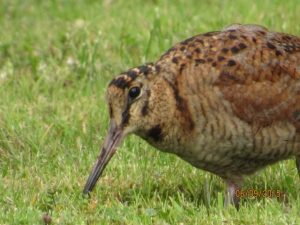Bird Notes by Jim Cassels
On Monday February 27 2023, following a petition with more than 100,000 signatures, the UK parliament debated limiting the shooting season of woodcock.
What is the background to this?
At present it is legal to shoot resident woodcock and those that have migrated here for the winter from Europe from October – September 1 in Scotland – until January 31. The petition requested that the opening of the woodcock shooting season be pushed back to December 1. At present an estimated 160,000 woodcock are shot across the UK, whilst research by British Trust for Ornithology (BTO) and the Game and Wildlife Conservation Trust (GWCT) show the woodcock population is in severe decline.
Woodcock species
There are eight species of woodcock worldwide, six in localised islands, one in America and one in Eurasia. The latter, as the name implies, occurs in Europe and Asia. The range of breeding habits of the Eurasian woodcock extends from the west of Ireland eastwards across Europe and Asia, mostly preferring boreal forest as far as Japan.
Woodcocks have stocky bodies, cryptic brown and blackish plumage, and long slender bills. Their eyes are located on the sides of their heads, which gives them 360° vision. The tip of the bill’s upper mandible is flexible. As their name implies, the woodcocks are woodland birds. They feed at night or in the evenings, searching for invertebrates in soft ground with their long bills. This habit and their unobtrusive plumage make it difficult to see them when they are resting in the day. In the breeding season, woodcock have a distinctive flight display known as roding usually given at dawn or dusk.
The research
Britain and Ireland support a relatively small resident breeding population of woodcock.
Counts of displaying males give us the best information on trends in our breeding woodcock and the current British and Irish population estimate is 55,000 males. The European breeding population is estimated at six-eight million males.
In winter there is a large influx of migrant woodcock from the main European breeding grounds in Norway, Sweden, Finland, the Baltic States and Russia. Migrants typically arrive from October to January, but the timing and numbers vary regionally within Britain and Ireland, as well as annually according to the severity of cold weather on the continent.
It is estimated between 800,000 and 1.3 million migrant woodcock winter in Britain and Ireland, with most departing in March.
Research by the BTO and GWCT shows a severe decline in the population size and breeding range of our resident woodcock. The extensive 2007-11 Bird Atlas data indicated a considerable 29 per cent reduction in range since the 1968-72 Breeding Atlas.
The current breeding range is less than half its 1960s extent. In addition, surveys conducted by BTO volunteers across Britain in 2003 and 2013, indicated that occupancy of 1km squares that contained at least 10ha of woodland dropped from 35 per cent to 22 per cent.
Given the scale of the decline, the woodcock was moved from amber to red status on the UK’s Birds of Conservation Concern in December 2015.
The future
The BTO Woodcock Survey was conducted again this year. Further information about it can be found at https://www.bto.org/our-science/projects/woodcock-survey The purpose of the national Woodcock Survey 2023 is to provide an updated national population estimate and assessment of range change compared to the surveys in 2003 and 2013.
In addition, habitat use will be investigated to improve our knowledge of habitat requirements, which can improve future woodland management for woodcock. This may cast light on the reasons for the decline. These may include recreational disturbance, drying out of woodlands, increased browsing by deer, declining woodland management and maturing of new plantations.
As GWCT stated in a recent report, at present, we cannot rule out shooting as a factor contributing to the decline of our resident woodcock.
What is happening on Arran?
Members of the Arran Natural History Society and members of the Clyde Ringing Group on Arran have contributed to the growing body of information through ongoing participation in the BTO Bird Atlas work, the annual Woodcock Survey and the sharing of data on woodcock that have been ringed and later recovered.
One recent example was a woodcock ringed on February 14 2021 on Arran that was recovered in Aberdeenshire on November 6 2021, probably on its return to Scotland to winter after breeding on the continent. It had been shot.
It is hard to believe woodcock is a red listed species in serious decline yet still being hunted and shot. I was dismayed when earlier this year I learned that six woodcock had been shot in the south end of Arran.
Outcome
What was the outcome of the debate on the petition in the UK parliament on Monday February 27 to limit the shooting season of woodcock? Nothing. Hansard states: “This House has considered e-petition 619615, relating to the open season for woodcock”. The debate in full can be accessed at https://hansard.parliament.uk/commons/2023-02-27/debates/AD214ECB-2D0C-4077-B834-0D0FFEA96039/OpenSeasonForWoodcock
Enjoy your birding.
Please send any bird notes with “what, when, where” to me at Kilpatrick Kennels, Kilpatrick, Blackwaterfoot, KA27 8EY, or email me at jim@arranbirding.co.uk I look forward to hearing from you. For more information on birding on Arran, purchase the Arran Bird Report 2022 and visit the website http://www.arranbirding.co.uk/index.html

Woodcock on the ground probing for worms. Photograph: Sonia Harding. No_B42woodcock01_23_feeding_Harding
A woodcock in flight. Photograph: Angus Hogg. No_B42woodcock02_23_flying_Hogg